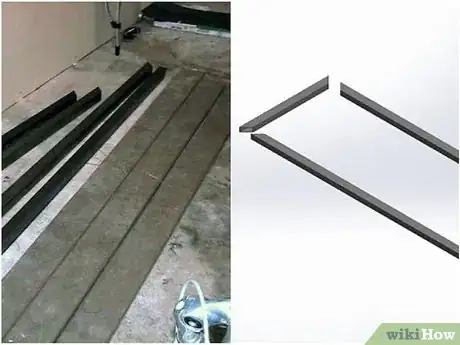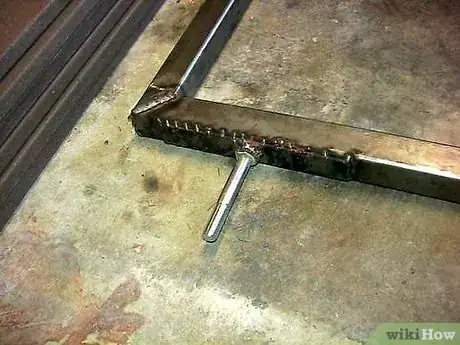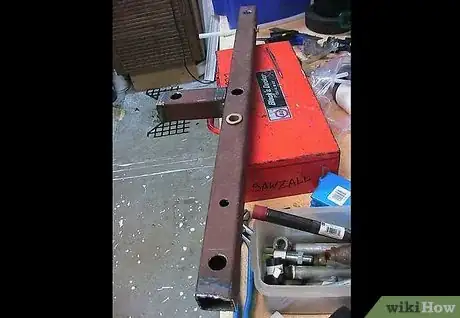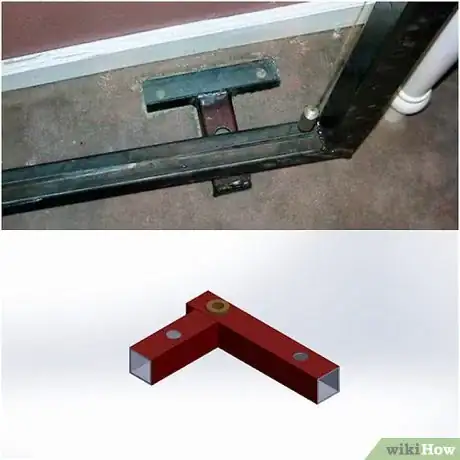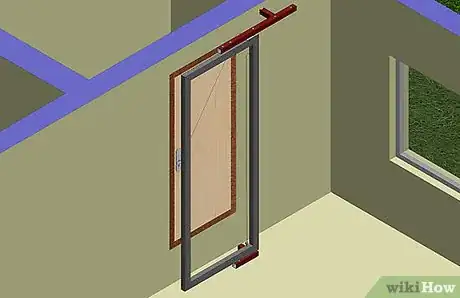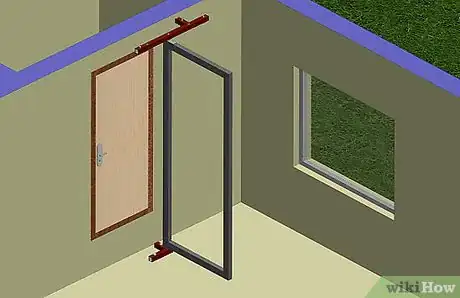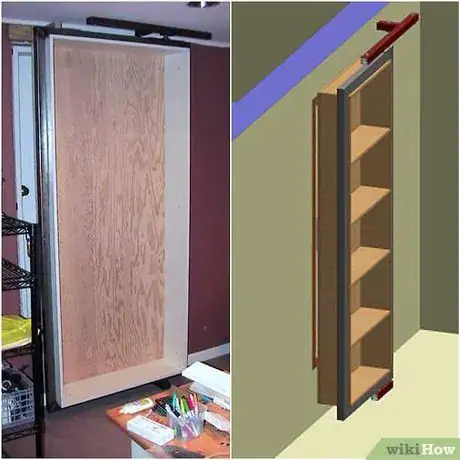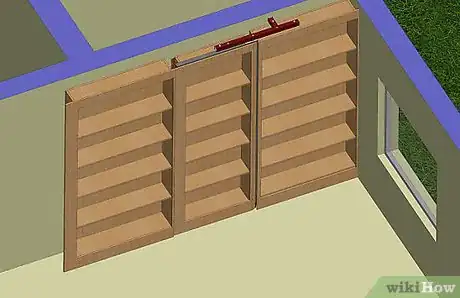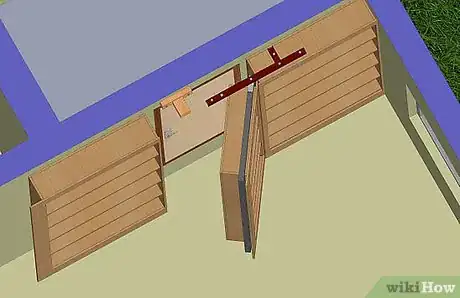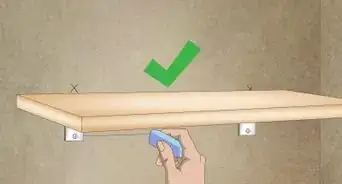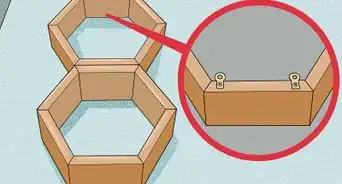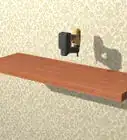X
wikiHow is a “wiki,” similar to Wikipedia, which means that many of our articles are co-written by multiple authors. To create this article, 39 people, some anonymous, worked to edit and improve it over time.
This article has been viewed 1,022,284 times.
Learn more...
Do you have a door to a storage area or, perhaps, a secret room? What better way to hide it than with a swinging bookcase? It not only indulges your inner mystery-lover, but it also makes extra use of an otherwise unusable or perhaps not aesthetically pleasing space. To build a hidden door bookshelf that you can customize to your own specifications, follow these instructions.
Steps
-
1Calculate the dimensions of your space. First, measure how wide the bookshelf will need to be to cover the door. Then, determine whether or not you can put the bookcase far enough away from the soon-to-be-hidden door that it can swing outwards without hitting any neighboring walls or furniture. Make sure that the hidden door won’t swing into the bookshelf, either.[1]
-
2Weld a steel frame to support the bookcase. Don't hinge the wood shelves directly; a steel frame made from box tubing will allow the door to swing easily and will support 500-1000lbs / 225-450kg (a full bookshelf) with no problem.
- Calculate the size of the frame. The width should just cover the access door and be centered. The height should allow a minimum clearance from the floor for trim and base board and enough clearance from the ceiling for the metal frame barely below the crown.
- Attach 3/4in (19mm) bolts to act as the pivot pins. First, weld a piece of scrap 1/4in (6mm) plate to each pivot point, one of which should be on the top of the frame and the other, directly opposite it on the bottom. Then,weld a bolt to each plate for extra strength. Finally, cut each bolt to 2in (5cm) long. Each pivot will fit inside a ceiling or floor mount that you will install later.
Advertisement -
3Install the steel frame.
- Build a ceiling anchor. An ideal piece of scrap steel (such as the one shown below) would already have holes in it for the pivot bolts. Size the ceiling anchor to span 3 joists. Add a short arm out to avoid rocking (which can be done with scrap steel). The short arm has to align with a joist or it will rock and break out the ceiling. Make the pivot point with a 3/4in (19mm) brass flange bearing inserted into a 1in (25mm) hole in the 2x2in (5x5cm) box.
- Build a floor anchor. Unless it will be bolted to a concrete floor (in which case it can be much smaller than the ceiling anchor), simply repeat the process outlined above.
- Position and place the top anchor, base anchor, and frame. Attach the top anchor loosely (letting it rock), slip in the frame and bottom anchor on the pin (with 2 washers on the pin above the bearing), then slide the whole set into place. Hang a plumb bob along the edge of the frame to tell if it is vertical in both directions.
- When true, secure bolts on both ends. At the pivot point, split a tiny piece (about 3/8in / 19mm) of nylon tubing and slip it on the exposed bolt. This keeps the bearing from slipping down.
- Test the swing of the door frame. For an accurate test, position 500lbs / 225kgs’ worth of people in it.
-
4Build the bookcase into and around the frame.
- Build the bookcase in the frame. When sizing it, be sure to verify the clearance. You can make the swinging bookcase 2in (5cm) shallower than the other shelves to allow clearance behind it for when it is swung.
- Build the two side bookshelves and install trim all around. To measure the clearance between the trim and the crown, use a credit card. The trim on the hinged side of the shelf-door should be attached to the fixed shelf; on the non-hinged side, however, it should move with the door. If the horizontal trim dives under it as the door opens, bevel notches in the trim on the right. If necessary, slightly round the horizontal pieces to slip underneath smoothly.[2]
-
5Install a wooden doorstop above the door. This can simply be a block of wood with a strong magnet (ex. a door magnet) held in place where the frame should ideally rest. This will not only hit the steel to keep the door from closing too far, but also hold the door so that it doesn't float open.
-
6Test the finished product. Make sure it swings nicely and looks inconspicuous.
Advertisement
Community Q&A
-
QuestionCan this be done in a small house?
 Community AnswerYes, depending on the size of your bookshelf. Take into consideration the space needed for construction too.
Community AnswerYes, depending on the size of your bookshelf. Take into consideration the space needed for construction too. -
QuestionHow do I make it possible to open the door by pushing on a fake book when building a hidden door bookshelf?
 Community AnswerTo make a book lever you need to use a latch on the inner side of the book case connected with wire through the wood to the book so when you tilt the book out it pulls the latch up. "I Like to Build Stuff" on YouTube has a good video on this.
Community AnswerTo make a book lever you need to use a latch on the inner side of the book case connected with wire through the wood to the book so when you tilt the book out it pulls the latch up. "I Like to Build Stuff" on YouTube has a good video on this. -
QuestionIs it possible to make this in a less complicated way?
 Ashton GilmoreCommunity AnswerYou could make it out of wood, but it would end up being thicker and not as compact. It would also lack the strength to hold large amounts of books.
Ashton GilmoreCommunity AnswerYou could make it out of wood, but it would end up being thicker and not as compact. It would also lack the strength to hold large amounts of books.
Advertisement
Warnings
- Make sure you are not violating any building codes by hiding the entrance to a room. Many building codes require, for example, that the entrance to a utility room with a furnace or gas line be clearly visible in case of emergency.⧼thumbs_response⧽
- Do not undertake any major projects or renovations if you are renting (unless you get prior approval from your landlord).⧼thumbs_response⧽
- Do not attempt this project if you are a welding or carpentry amateur. This is an advanced do-it-yourself project.⧼thumbs_response⧽
- Always take proper safety precautions when working with welding equipment and sharp tools.[4]⧼thumbs_response⧽
Advertisement
Things You'll Need
- Carpentry equipment
- Welding equipment
- Steel 2x2 box tubing (recommend 2x2x3/16in / 50x50x5mm, as thinner material wouldn't support the weight but thicker is too heavy to work with) cut to length with miters
- 3/4in (19mm) bolts
- 3/4in (19mm) brass flange bearings
- Plumb bob
- Medium density fibre board and particle board
- Wooden doorstop
References
About This Article
Advertisement

